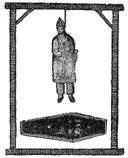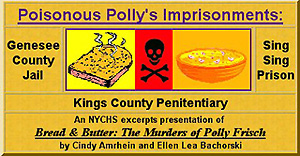|
James McLean: Double Murderer, Doubly Hanged
By Roger Larson*
I felt I ought to contribute this information to the NYCHS web site after finding in its section on "Executions by Hanging in New York State" an article describing the execution of one James McLean in 1807.
I want to share with the web site's readers the results of my own research into this particular subject, an inquiry I pursued with special attention toward the victims as well as the perpetrator. One of the victims, Archibald MacLachlan, was a distant relative of mine. That is what originally drew me to this early New York execution.
XXX

This article's author , Roger Larson, has enjoyed a rewarding career spanning over three decades with one of the domestic U.S. automakers.
Presently he manages its private satellite broadcasting studios that provide national dealership and employee training and corporate communications.
Genealogical research is a hobby spawned by an early impassioned interest in his maternal family's genealogy records originally compiled in the late 1920s.
Expanding this interest to other family members led him to pursue his research in Scotland, Sweden, Canada and throughout the Eastern and Midwest U.S. He has visited numerous locations in New York seeking and collecting information for this article. |
|
Further, while the information on the NYCHS site was essentially correct, I did notice a few things that I concluded, based upon my personal research, should be corrected.
To that end, I am submitting the following information regarding the two homicides and subsequent execution in this case that occurred nearly 200 years ago.
Background
To begin, I should inform the reader that the village today named Caledonia, N.Y. was originally christened Southampton. Some accounts claim the settlement was briefly named Northampton prior to Southampton.
With the movement of so many Scot immigrants into the area in the late 18th and very early 19th century, the town's name was changed in 1806 to Caledonia, the ancient name of Scotland.
In order to provide relevant background, it is helpful to note that, in addition to local Native Americans and various European settlers, the settlement area was comprised of two distinct Scot immigrant societies, considered either legal or "illegal" landholders.
Certain property had been purchased outright by the newly-arrived Scot faction known as the Inverness group, while the other Scot immigrant society, known as the Perthshire group, had arrived and settled some time earlier on the lands known as The Donation Lands.
There was considerable strife and disagreement between these two groups, primarily over the right to hold and occupy these lands. It is this discord between the two groups that, in my opinion, provided the basis and fundamental animosity for the altercation which led to the murders.
While I have no solid evidence, I believe that the perpetrator, James McLean and my relative, Archibald MacLachlan, one of the victims, were both of the Perthshire Group, and that William Orr, the other victim, was from the Inverness Group.
XXX
 Above is a portion of the Caledonia 1872 plat map. The two 'Springs' are clearly visible just west of the pond, which today no longer exists. Red arrow added to indicate location. Above is a portion of the Caledonia 1872 plat map. The two 'Springs' are clearly visible just west of the pond, which today no longer exists. Red arrow added to indicate location. |
|
While the two groups are reported to have worked well together for projects of common interest, I base this conclusion on the mere fact that only Orr's murder resulted in an official inquisition [inquest], and that his estate, while he died intestate, was administrated by the State of New York at Batavia in May, 1808.
Beginning in 1802, the town of Southampton grew outward from two springs that flowed into a small pond where Spring Street (formerly Water Street) today divides the springs from the pond site. In 1805, John Cameron moved to this community from Geneva and opened a store combined with a tavern on this site. It was this tavern that was commonly referred to as "The Springs."
Consuming alcoholic beverages was a rather common daytime practice, as evidenced by the stories surrounding the murder and the account of two constables who submitted an expense account for conducting a week long search for James McLean, the homicidal desperado.
XXX

One of Caledonia's 'Springs' as it appears these days.
Photo by Roger Larson. All rights reserved.
|
|
The Site of the Murders
While some reports have indicated that the murders occurred on a site which is now Graney Road, my research deems that not to be the case. I do have evidence in the form of an extensive genealogy compiled in 1929 by my Mother's granduncle stating my ancestral MacLachlan relatives' estates were located approximately three and one-half miles south of the town of Caledonia.
According to the 1872 Plat Map of the area, the two MacLachlan (also spelled McLaughlin) estates were located on the south side of DeNoon Road. DeNoon Road continues westward to the end of what originally was the D. McLaughlin farm, and then turns abruptly southward for approximately 1/4 mile where it then turns into McKenzie Road.
XXX

1852 plat map detail shows C. Orr, the D., and A.D. McLaughlin and the D.A. McColl estates. D.A. McColl is most certainly Donald, the teenage witness. The C. (Collin) Orr estate on McIntyre Rd just north of the A.D. McLaughlin estate would be murder victim William Orr's surviving heir. Red underlines added for emphasis.
|
|
At this junction, a short, unnamed dead end roadway extends westward from McKenzie Road as shown on the 1872 plat map, and stops at the location of the original D. A. McColl estate. This described area is three and one-half miles south of Caledonia, just around the corner from the MacLachlan estates' locations identified in the genealogy, and as quoted in several news accounts.
Today, that short road has become a driveway for a farmhouse. It was from this site that Mrs. McColl and her son were able to eyewitness the events leading to the murders of the two men. For this reason I have concluded that the site of the murders actually occurred nearby the junction where DeNoon Road turns into McKenzie Road.
XXX
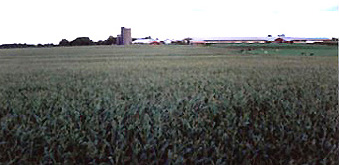
Above: A photo looking south from DeNoon Rd of the D. & A.D. MacLachlan estates as they appear these days. The murder site would be to the right. These lands were held in the MacLachlan name until 1916.
Below: A photo looking southward at the junction of DeNoon & McKenzie Roads. The driveway just opposite the farmhouse is the original access road to the D. A. McColl homestead near the exact murder site.
Photos by Roger Larson. All rights reserved.

|
|
Could the murders have occurred as one contributor suggested on Graney Road where at least two other 'McColl' homesteads (as shown on the 1852 plat map above) were located? I say no.
Remember, Mrs. McColl and her son Duncan witnessed the incident, she from her cabin and Duncan from nearby as he cleared brush. Further, although a homestead listing on a plat map could not be found nearby for McLean, the McColls, the MacLachlans and the Orrs all lived within 1/2 mile of one another.
On the 1852 plat map, there is an A.H. McLean site located about 1 mile northeast of Caledonia, but it is unknown whether this is the same family. Also, the Graney Road locations would be only two miles at most from town, not the three to three and 1/2 as quoted.
The Murder of Archibald MacLachlan
Numerous accounts exist of the circumstances surrounding the murders of Archibald MacLachlan and William Orr, each one with varying details. In an effort to sort through the facts, the following account takes all versions into consideration as well as the actual inquisition and execution of the murderer, James McLean.
XXX
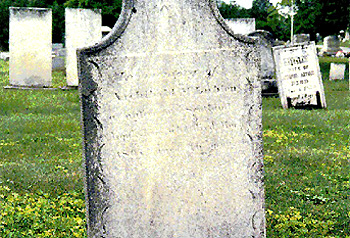
The tombstone of Archibald MacLachlan reads:
“In memory of Archibald McLachlen, a native of Scotland, Argyleshire who died March 16, 1807,
aged 46 years.”
Archibald was actually 38 when murdered.
|
|
The murders occurred on a newly constructed road south of the village of Southampton, now called Caledonia. It is believed that the three men had been to “The Springs” (Caledonia Springs) and were to some degree, under the influence of alcohol.
An argument broke out between William Orr and James McLean, a man known for his ill-temper, allegedly over Orr having felled a whitewood tree (likely basswood or American linden) on land claimed by McLean.
It is asserted by one account that all three were squatters on land known as "The Forty Thousand Acre Tract," and that all three had been clearing land to build the new road.
XXX
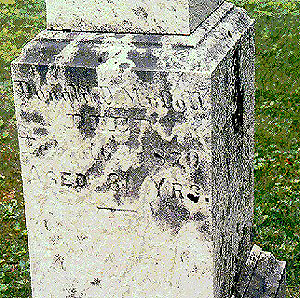
The Donald D. McColl tombstone: “Died Feb. 16, 1870,
Aged 81 Yrs.” He was 17 in 1807 when he witnessed the murders.
|
|
McLean suddenly raised his broad axe and struck William Orr four times, two fatal blows to the throat, one in the left shoulder and one in the left side.
The Inquisition of James McLean provides a detailed account of the events.
Archibald, nearby, ran over to Orr and knelt over Orr’s body, reputedly reproaching the assailant, “Oh Lachlin, Lachlin, what have you done now?”
Archibald too was struck down.
One fatal blow to the upper back was reported as “cutting him down to the very heart.”
Both victims apparently died instantly.
XXX

The graves of William Orr and his widow Mary. His inscription reads: ”In memory of William Orr,
a native of Argyle shire Scotland who died March 16, 1807.”
Her’s reads: “In memory of widow Mary Orr a native of Argyle
shire Scotland who died Jan. 14, 1821. aged 71.”
All tombstone photos taken by Roger Larson in Mumford Rural Cemetery,N.Y. All rights reserved.
|
|
McLean fled and took refuge in the dense woods, but his deed was witnessed by Mrs. Duncan McColl from her nearby cabin, and by her teenage son Donald, who had himself been clearing brush nearby from the intended roadway.
Donald rushed forward, grabbed the axe from McLean, ran, and hid it.
The lad was fortunate to have outrun the frenzied McLean.
He was able to make his way three miles to town and rouse the citizens.
That happened March 16, 1807.
McLean initially managed to elude his pursuers, a militia led by Judge Ezra Platt. The fugitive hid out in the forest, allegedly sleeping in a hollow log and secretly receiving food from his mother.

An expense sheet (detail above) submitted by two constables, Seymour Kellogg and Benham Preston, covers charges incurred hunting McLean for one week, logging a total distance of nearly 115 miles on horseback.
Daily entries might include a "pint of whiskey," or a "gill of brandy" or a "dram of bitters." One amusing entry was "At Gen'l Hales - entertainment one night and breakfast - $2.50."
McLean was finally caught in a tavern at Canandaigua, N.Y., having been recognized by the landlady who had noted McLean’s unusually long arms and his keen interest in reading the “wanted poster” on the wall. It was said that McLean's fingertips reached well below his knees when his arms hung at his sides.
McLean was arrested and jailed at Batavia, N.Y. by Sheriff Benjamin Barton.
XXX
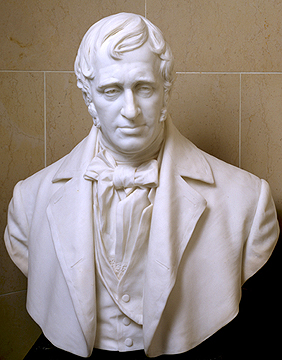
An 1891 marble bust of Daniel D. Tompkins, sculpted by Charles Henry Niehaus, is part of the U.S. Senate's Vice Presidential Bust Collection in the U.S. Capitol. Click image for more about it.
|
|
Orr’s inquisition was held on March 27th, 1807, and McLean was found guilty of the murder of William Orr at trial in June, 1807. He apparently was tried only for Orr’s murder and not MacLachlan’s by the Hon. Daniel "Thompkins" and was defended by "Judge" Nathaniel W. Howell.
The Judge/Gov./V.P.
Tompkins "Teaser"
During research into this case, the identity of the judge who presided at the McLean's trial emerged as an unexpected puzzlement. Generally, the accounts that mention the trial judge give the last name as Tompkins (or Thompkins), and, where a first name is included, give that as Daniel. One or two sources actually include "D" as the middle initial.
Run an Internet search for an 1807 New York State Judge named Daniel Tompkins (with or without the middle initial "D") and you find scores of web pages about the judge Daniel Tompkins (with or without the middle initial "D") who became New York State governor and U.S. Vice President and for whom the Tompkinsville community on Staten Island, Tompkins Square Park in Manhattan, and a county in New York State are named.
But look closer and problems become discernable with regard to identifying the McLean trial judge as that later governor and Vice President. The trial took place in June 1807. The official New York State web site lists Daniel D. Tompkins of Richmond County serving as the fourth governor of the state from April, 1807 through February, 1817 when he became V.P. His predecessors as governor -- George Clinton, John Jay, and Morgan Lewis -- had served periods that began and ended in Aprils.
XXX

Red underlines have been added here to our cropped version of a document image in Westchester County's Virtual Archives. That handwritten document certified Scarsdale's vote tally in the April 28, 1807 gubernatorial race. The red underlines were added here to call attention to the April 1807 dates and Tompkins brothers' names. Click image for the original from its source.
|
|
A Westchester County Archives document, available on-line, is relevant in this connection. Dated April 30, 1807, it records the April 28 Scarsdale votes for state office in the election of 1807, when Scarsdale native Daniel D. Tompkins ran for Governor. The vote certification is signed by three leading citizens of Scarsdale. One was Caleb Tompkins, Daniel's older brother who also was a state judge in 1807.
The statewide outcome in the 1807 gubernatorial race was finalized April 30 and showed Daniel D. Tompkins winning by a majority of 4,085 votes over Morgan Lewis' 30,989, according to
Dr. James Sullivan's The History of New York State Book XII, Chapter 5, Part 1.. That same source notes Tompkins' formal inauguration as governor did not take place until about seven weeks later.
Sullivan's history cited the June 22 attack of the 50-gun British frigate Leopard, upon the 38-gun U.S. frigate, Chesapeake and then noted that, "On the very day that the Chesapeake limped back into Norfolk, the people of New York were inaugurating their new Governor."
Would Daniel D. Tompkins, elected governor April 30, have been presiding as the McLean trial judge in June prior to his formal inauguration circa June 22? Even if government operated with greater flexibility back then, such a scenario seems strained.
Could the trial judge named Tompkins been Caleb, Daniel's older brother who also had served in the state legislature and Congress but whom history has pushed into the shadows as it focuses the spotlight on the superstar sibling?
XXX

In 2000, the former curator of Genesee County's Holland Land Office Museum & Holland Purchase Historical Society Lisa Westric created an exhibit Sensational Crimes of Genesee County.
The exhibition featured the original execution gibbet for Genesee County and listed James McLean as the first of the seven condemned men executed via the gibbet.
|
|
Could there have yet a third NY state judge Tompkins or Thompkins serving simultaneously with Caleb and Daniel in 1807? Or could the sources be completely wrong as to the trial judge's name being Tompkins or the like?
It's a teaser.
"Judge" Howell Interesting Too
Nathaniel W. Howell, born in Blooming Grove, Orange County, N.Y., Jan. 1, 1770, and died Oct. 15, 1850, was the first judge of Ontario County, serving 1819 - 1833. Before that he had served in Congress 1813-1815. One of the more interesting documents bearing the judge's signature as "first judge of the Court of Common Pleas of the County of Ontario" was an April 25th 1821 Certificate of Freedom that found "a black man" named Nathan Franklin, "48 years about" from Maryland "is in my opinion free according to the laws of this State ."
Interestingly, at one time, Howell himself briefly "owned" a slave Lloyd Colbert whom he had purchased in 1812 from a Daniel Dorsey. But Ontario County records seem to suggest Colbert had been released and was on his own by 1814.
XXX
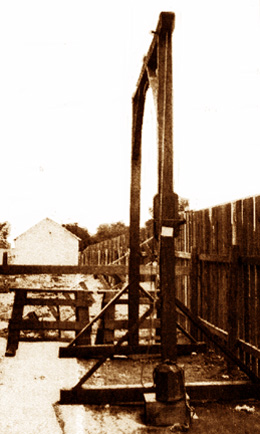
Whereas with a conventional gallows the condemned dropped down when the trapdoor opened, a gibbet -- such the one shown above in an image based on a published Genesee County History Department photo of the Holland Land Office Museum's gibbet-- was instead operated by using a counter balance. The condemned stood on the ground, and a weight was held by a bracket. When the weight was released, the rope pulled the convicted criminal up.
|
|
For his client Mclean, "Judge" Howell envoked a right that existed then entitling an “alien” (term for an immigrant not yet a naturalized citizen) to be tried by a jury one half of which were aliens themselves. In accordance with this demand by his counsel, McLean's jury was changed to satisfy this right.
The jury -- half-citizen/half-alien -- nevertheless convicted McLean and sentenced him to hang in August. The jury was comprised of Benjamin Morgan, Ebenezer Cary, Samuel Geer, Worthy L. Churchill, John Oney, and Daniel Fairbanks, all citizens. The “aliens” were Duncan McLelland, James McLelland, John McPherson, John McVane, Daniel McKinney and Patrick Powers.
Condemned Man
Hanged Twice?
James McLean was hung August 28th, 1807 by Sheriff Benjamin Barton in front of a great crowd that gathered to see the first public execution in Genesee County, New York.
The story has been told and retold that during the hanging the rope broke and McLean fell to the ground, shaken and stunned but alive. While another rope was being secured, McLean was reputed to remark, “As I killed two men, I deserve two hangings.” Another version has McLean protesting a second hanging since he had been convicted of only the one murder and had already been hung for that.
For the oft-told story to be true if the gibbet was the execution device -- as indicated by the museum exhibit mentioned above -- the rope would have had to break as the counterweight fell to jerk McLean off the ground into the air. The mechnanism is designed to break the neck by sudden upward suspension. Its proponents regarded the device's design more humane because, they argued, it was consistently more successful inflicting quick death by neck breaking than trapdoor gallows whose drop-down method also sought to break the victims' necks but too often instead resulted in slow and agonizing deaths by stragulation.
XXX
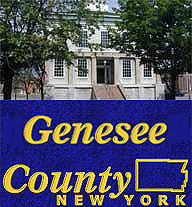
Image above is a composite of elements in the logo of the Genesee County web site. Click it to access the "Historian's Note" on the case.
|
|
Although spelling the name as "McClean," a note by the county historian on the official Genesee County web site tells the story consistent with a gibbet having been used as the execution device:
A great crowd from all parts of the County attended the public execution on August 28, 1807. It was reported in the newspapers that when the weight fell, the rope broke and McClean fell to the ground. He soon recovered from the shock and rising to his feet, expressed a strong desire not to be "hung again." Some insisted that one hanging was a fulfillment of the law. Others, however, thought differently and informed McClean that "as he had killed two men, he ought to be hung twice." (Remember that he was only convicted of killing one.)
The County Clerk was dispatched by the Sheriff for a new rope. He soon returned with a "trace rope" sufficiently strong and after considerable delay, the miserable culprit was again mounted upon the scaffold and launched into eternity!
A further note: William Keys was paid $8.25 by the County Supervisors for building the gallows. Eight gallons of brandy was also supplied to the guards.
XXX
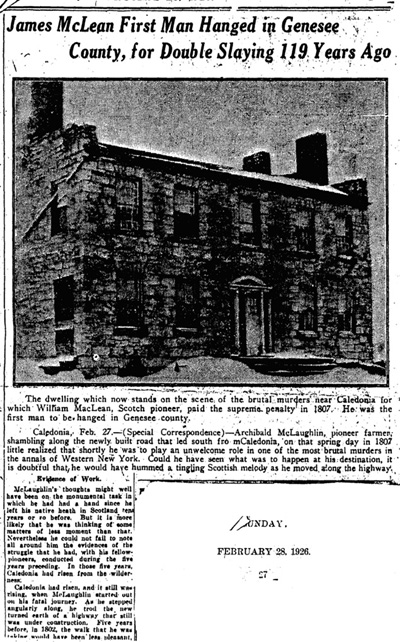
Image of part of a Sunday, Feb. 28, 1926 Page 27 Rochester newspaper clipping of a story recalling Genesee County's first hanging execution.
Click image for clipping's full text.
|
|
A Rochester newspaper account of Feb. 28, 1926 reported:
It is said that during the time [McLean] was in jail, he was visited by a clergyman who found him a sincerely penitent man and who was able to convince him that a merciful God would forgive him. In that hope, he met his death. The story is told that the rope broke as McLean’s weight fell. While another rope was being secured, McLean remarked that as he killed two men he deserved two hangings.
The Progressive Batavian recounted the hanging in a Nov. 12, 1880 story:
On August 28th, 1807, over 73 years ago, James McLEAN was hanged in this village for the murder of Wm. ORR . . . He was arrested in Canandaigua, and brought to Batavia for trial. The gallows was erected at a point in the rear of where C.H. TURNER & Son's market now stands, and the stumps of the gallows posts, which, apparently, were made from a black ash tree cut in two parts, stood there, well preserved, for many years.
XXX
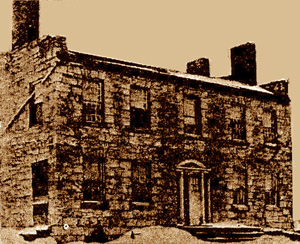
The house in the Feb. 28, 1926 Rochester newspaper clipping was wrongly identified in the story as on the site of the double murder.
Click image for clipping's full text.
|
|
At the execution a shocking scene occurred, McLEAN being hung twice. The first time the rope broke, and a bed cord was procured from the house of Chauncey KEYES, which was doubled, and the execution proceeded. The murder created the most intense excitement throughout this region, and the hanging was witnessed by a large crowd composed by people from great distances who assembled to see the murder of ORR avenged. It was the all-absorbing topic of conversation at that time, and the story of the crime and the punishment was told and retold hundreds of times during the succeeding score of years.
McLean ironically was an uncle to Alexander McLean, the chief of police in Rochester, N.Y. for many years. No record has been found identifying McLean's burial location, but it may be assumed he was buried somewhere in or near Batavia, possibly in Batavia Cemetery on Harvester Avenue. The first burial there was recorded in 1806.
Research into this oft-told tale of "the man hanged twice" illustrates the truism that details sometimes get mangled in the retelling process. But in this case enough firm facts survive relatively unscathed that the basic story can still be recognized.
As a descendant of Archibald MacLachlan, for whose death James McLean was not prosecuted, there is some satisfaction that his homicide received at least symbolic recognition in the comments, variously attributed, that were expressed when the first execution attempt failed.
|

